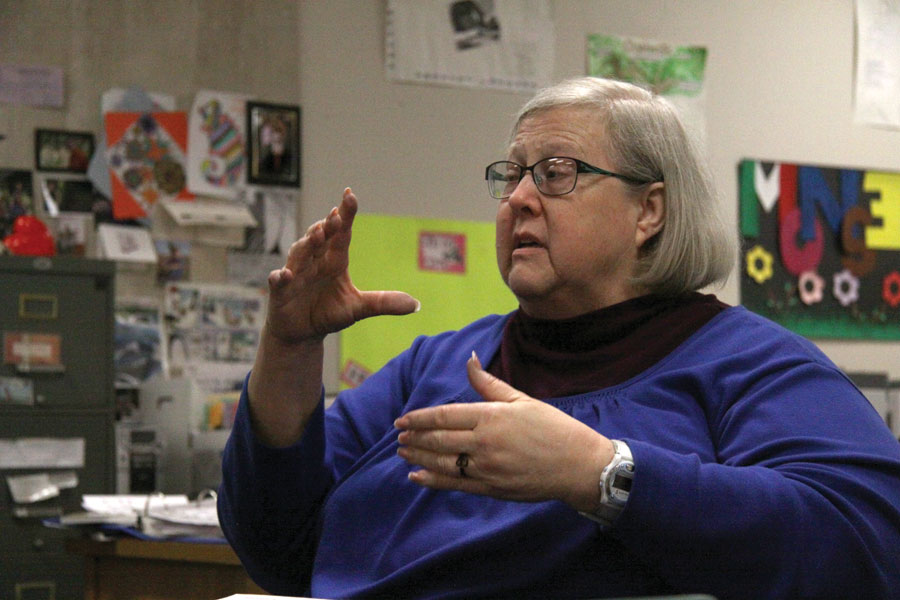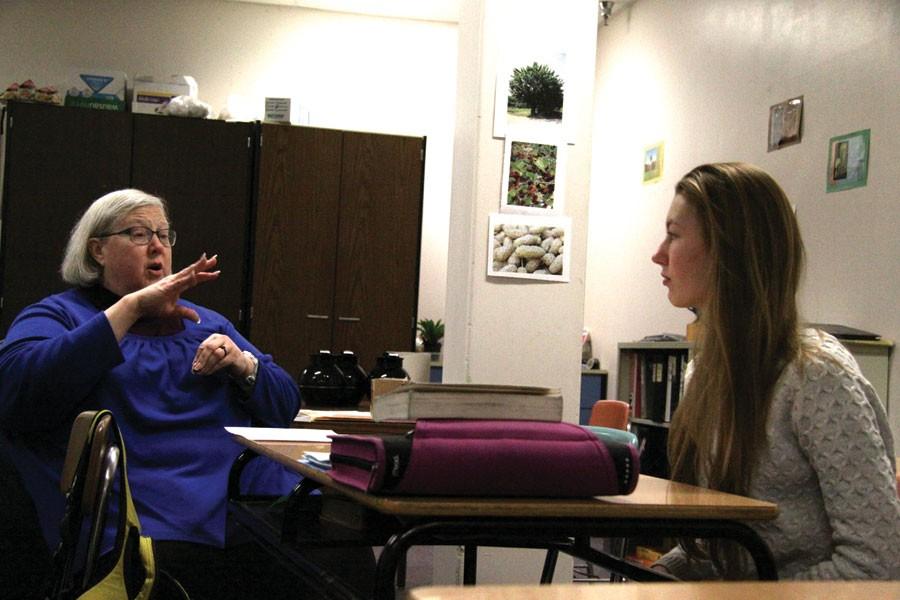Educational Interpreter Marti Minard signs to her student. “Every student is different … some students are more oral, so you do voicing too. Some are good lip readers. Some are just strictly signing.”
A hands-on approach
Educational Interpreter Marti Minard recounts how she became fluent in American Sign Language and describes the challenges of being an interpreter
February 11, 2015
Her stage is the classroom and her script jumps between teacher’s instructions and students’ responses. Coming into character, she must strip herself of opinions and influence to combine a dichotomy of objectivity and vivid animation.
Majoring in drama during college, Marti Minard, Educational Interpreter for the Deaf, never thought she would know American Sign Language and act as a bridge between teachers and deaf students. But having spent 24 years in classrooms around North Central Washington, her job as an interpreter, which demands stepping out of personal character and into one dictated by others, is perhaps Minard’s greatest role.
“One of the exercises I learned at an interpreter class was to go to a party or group of people and just stand there with your hands at your side, looking pleasant, but just stand there,” she said. “It’s very disconnecting, and as an interpreter that’s just someone you want to be, not distracting, not imposing yourself. You are just there doing your job; you are just in a box.”
The manner in which Minard stepped into this “box” or job was far from planned.
“I took a [sign language] class at my church. It was fun, and then they had a class at the college, and I took that for fun, and that was it. And like two years later I got a call from one of the school districts, and they were like, ‘We have a deaf student and no interpreter, and we understand you know sign language. Would you come in and interpret?’” Minard said. “I was like, ‘I don’t know how to interpret!’ And they said, fatal words, “You are better than nothing.’”

Marti Minard has worked throughout the Wenatchee School District and teaches at Wenatchee Valley College.
The mother in her took over, and Minard stepped up to the position, working with who she said was a wonderful teacher and a patient student to make it through that first year. Today, Minard has worked in nearly all schools of Wenatchee School District and teaches American Sign Language at Wenatchee Valley College. This year, she is working with a student at Wenatchee High School.
“Most of the time, you don’t keep a student for more than two to three years because when they are little you kind of get bonded, and they need to know different vocabulary, different signing styles, and if they just have one interpreter, they never get a chance to learn other techniques,” she said.
Considering the amount of time an interpreter spends with a student, typically the entire school day, it’s no surprise that it can be hard to let go of that relationship. Minard said this is especially true with younger children, who she “invests” herself into by actually teaching the language. Yet, exactly what and how she interprets depends on each student.
“At the high school level, I basically just interpret. I’m not explaining or showing as I would with a kindergarten or younger child,” Minard said. “Every student is different… some students are more oral, so you do voicing too. Some are good lip readers. Some are just strictly signing.”
Though she can’t copy every sound that occurs in the classroom, Minard tries to catch all of the teacher’s instructions by being the first to arrive and the last one to leave in each of her student’s classes.
“It’s difficult when I’m signing a subject that I don’t care for. I really have to put myself forward to make it as interesting as I can to the student to try to get the teacher’s enthusiasm across without it burning out in me,” Minard said.
Besides replicating the teacher’s passion, Minard must voice her student’s responses as genuinely as she can. Taking that step back and only translating the message is what she said makes the job both challenging and interesting.
“You learn to dissociate yourself. Sometimes you feel responsible if your student does something stupid or wrong. If my student says a lie, I have to voice that lie. And I have to voice it with as much sincerity as the student. I can’t roll my eyes,” she said. “That’s part of the training, to be neutral. To be able to mirror what they are saying through expressions.”
While speaking relies on tone, volume, and inflection, signing relies on body language, gestures, and facial expressions to convey a message. Grammar and spelling also gets lost in the translation.
“American Sign Language is a conceptual language, so you are not signing words in a sentence; you are signing the meaning of the sentence,” Minard said. “Some people are really self-conscious at signing, and they are not comfortable laughing at themselves, and when you do sign language, you do all sorts of silly things.”
Like any language, American Sign Language constantly evolves to include new phrases and accommodate technology. This impact goes beyond words to the state of deaf speakers, who Minard said have become less isolated with services like texting and Skype aiding communication. Additionally, she believes the trend of deaf students attending mainstream schools like WHS is growing, and it offers a great opportunity for both type of students to interact. However, she said with like most things, it’s not perfect.
“The idea is equal access to everyone, and in order to do that you would need an interpreter to stand at each desk in the classroom, and each time a student says something, an interpreter would sign that, and that is just not going to happen,” Minard said. “There is no such thing, really, as equal access, but they certainly try.”
Though not the same, the life of the deaf is not limited; rather, it’s one Minard appreciates. “It’s a whole different culture, a whole different life, and it’s fun to stick my foot into that side of the culture,” she said. “There are so many things they perceive differently since they don’t hear. I find that kind of thing fascinating.”

